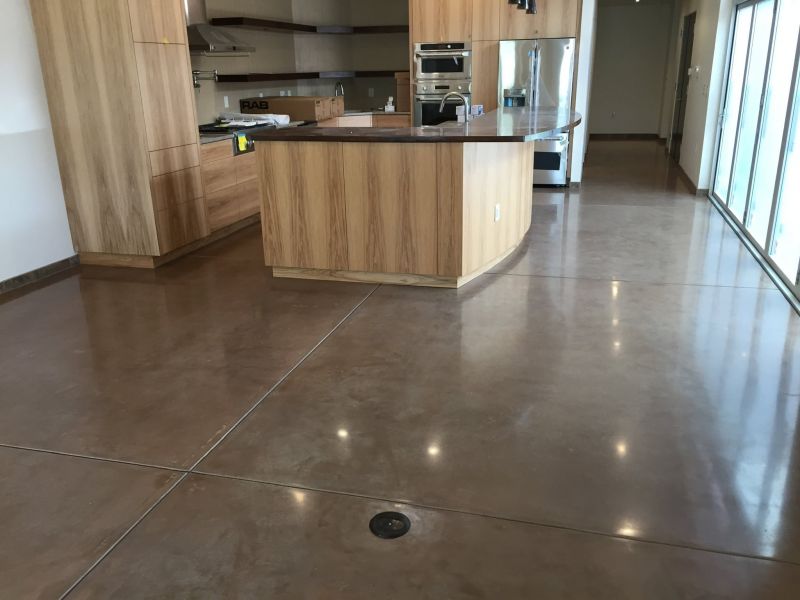
Professional Concrete Care Guide
Congratulations! Your decorative concrete flooring, wall cladding, and furniture tops are an investment in lasting beauty that will give you many years of wear. This care guide provides information on how to properly care for your decorative concrete and extend its life and beauty.
Regularly scheduled professional maintenance, in conjunction with some simple precautions, and the use of proper cleaning methods and products, will insure a lifetime of use from your decorative concrete.
Cleaning Recommendations
Concrete is a strong and durable material which can afford many years of beauty and function. We usually think of concrete as solid and hard, however, in reality it is a very porous material that can absorb soil and stains, as well as sustain etching and erosive effects if left untreated.
Keeping your concrete free of dust and dry, sandy soil will minimize the scratches and wear patterns that can develop from everyday use of all concrete applications.
Sweep or dust concrete surfaces regularly to remove loose soil and dust and prevent the “sandpaper” effect.
Clean your decorative concrete on a regular basis with warm water and a clean, non-abrasive cloth, sponge, or mop.
In addition, use only pH neutral cleaners to help remove soils that normal dusting or damp mopping leave behind.
DO NOT use general, all-purpose cleaners.
Such products contain lemon, vinegar, or other acids and alkalis that may etch or dull the concrete surface and damage the polish and degrade the sealer. DO NOT use scouring pads, powders, or creams as these will scratch concrete surfaces.
Countertops, Vanities, & Showers
Many common foods and drinks contain acids that may etch or dull the concrete surface. Also, some common toiletries (e.g., perfume, soaps, shampoos, hairsprays, toothpaste, and mouthwash) contain acids, alkali, and other ingredients that may damage concrete surfaces and degrade sealants.
These contaminants should be cleaned up promptly to extend the life and luster of vour decorative concrete.
Use of a squeegee in the bath and shower after each use, is excellent preventative maintenance which will extend the life of the sealant and help to reduce soap scum and hard water and calcium deposits.
Floor Surfaces
Dust mop or sweep interior floors frequently as sand, dirt, and grit do the most damage to concrete surfaces due to their abrasiveness.
Place quality mats or area rugs both inside and outside each entrance to minimize introduction and spread of potentially damaging particles. In addition, use extra care when using a vacuum cleaner, as the metal or plastic attachments or wheels may scratch the surface.
Allow mud stains to dry completely, and then remove with a soft nylon or plastic brush.
Damp mop concrete floors using plain warm water, or again, as necessary, using a specially formulated pH neutral cleanser.
Avoid walking on your floor until it is completely dry as concrete can be particularly slippery when wet.
When Spills Occur
No matter how careful you are, spills are going to happen.
A quick response and the right solutions can keep spills from damaging your concrete or the sealant. Again, it is most critical that the cleaning products you use are specifically neutral, in order to prevent further damage to the surface and sealant.
Etches – Substances that are highly acidic, such as fruit juices, coffee, vinegar, wine, tomato products, mustard, and soft drinks will etch any concrete surface – whether it be sealed or unsealed. Although the sealant allows time to wipe up a spill, it cannot stop the chemical reaction that may leave a dull area or etch mark in the concrete itself.
In addition, cleaners which are not pH neutral mav etch away the polish, discolor the surface, scratch the concrete, or degrade the sealant.
That is why selecting the proper cleaning products is so critical to the lifelong beauty of your decorative concrete. Consult your concrete care professional for suggestions on which products are best for your concrete.
Professional refinishing is the best way to permanently remove etch marks and restore your concrete’s even finish.
Last, but certainly not least…
Care and maintenance of the decorative concrete medium is as much a precise science as it is an art form. After your concrete is installed, it will be critical to begin regular care and maintenance of your investment by selecting and hiring an experienced and reputable concrete care professional to perform the initial, and very critical, cleaning and sealing.
Your concrete care professional will also be able to recommend regular inspection and maintenance schedule which is specifically customized to suit the type and specific application of concrete medium you have. This is as essential to the life of your concrete as regular maintenance is to life of your automobile.
This publication is offered without obligation as a public service by:
Tile Renaissance
Tucson, AZ
520-272-0815
Contributions By:
StoneTech Professional, Inc.
29500 Kohoutek Way
Union City, CA 94587
510-477-6888
www.StoneTechPro.com
The National Training Center for Stone and Masonry Trades
1413 Haven Drive
Orlando, Fl 32803